Business Strategy: Waitrose's Mission, Vision, and Strategic Analysis
VerifiedAdded on 2020/06/05
|14
|4212
|58
Report
AI Summary
This report provides a comprehensive analysis of Waitrose's business strategy. It begins with an introduction to business strategy and its importance, followed by an examination of Waitrose's mission, vision, goals, objectives, and core competencies. The report then delves into the factors considered when formulating a strategic plan, the evaluation of techniques like the BCG matrix and SPACE analysis, and an environmental audit of the company using SWOT and PESTLE frameworks. It explores strategic options such as market penetration, product development, and diversification. The significance of stakeholder analysis is discussed, and the report concludes with an assessment of the roles and resources needed for strategy implementation and the contribution of SMART targets. The report aims to provide a detailed understanding of Waitrose's strategic planning and execution.
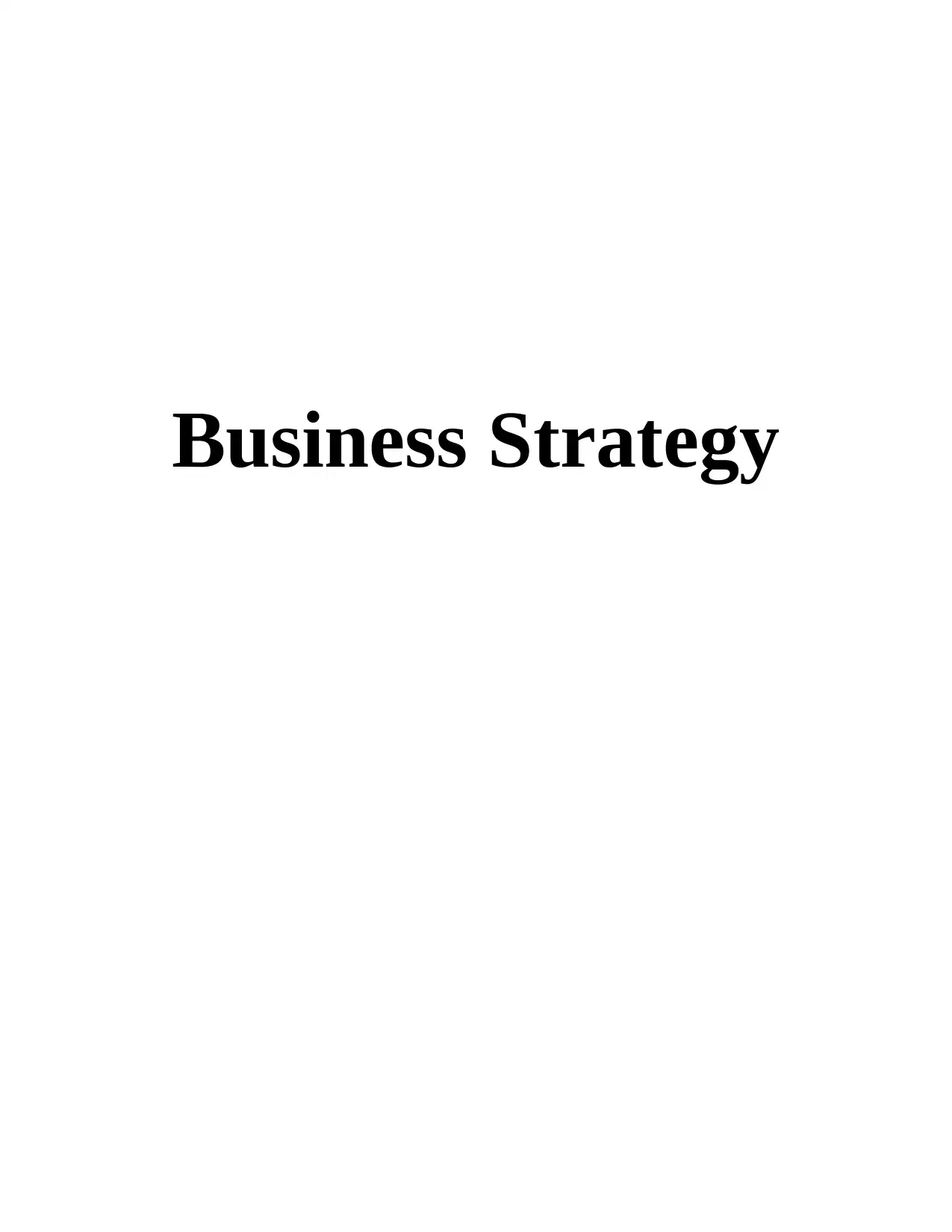
Business Strategy
Paraphrase This Document
Need a fresh take? Get an instant paraphrase of this document with our AI Paraphraser
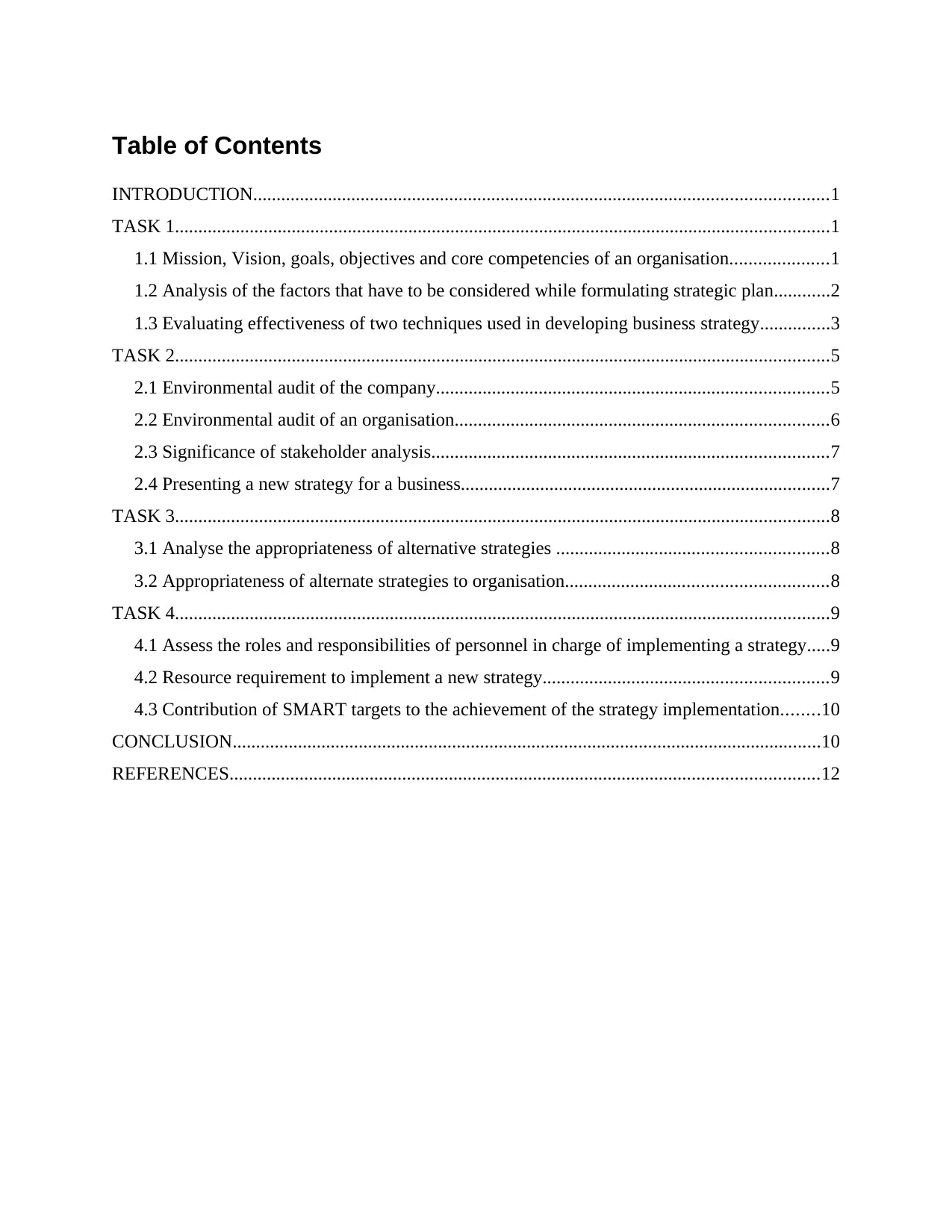
Table of Contents
INTRODUCTION...........................................................................................................................1
TASK 1............................................................................................................................................1
1.1 Mission, Vision, goals, objectives and core competencies of an organisation.....................1
1.2 Analysis of the factors that have to be considered while formulating strategic plan............2
1.3 Evaluating effectiveness of two techniques used in developing business strategy...............3
TASK 2............................................................................................................................................5
2.1 Environmental audit of the company....................................................................................5
2.2 Environmental audit of an organisation................................................................................6
2.3 Significance of stakeholder analysis.....................................................................................7
2.4 Presenting a new strategy for a business...............................................................................7
TASK 3............................................................................................................................................8
3.1 Analyse the appropriateness of alternative strategies ..........................................................8
3.2 Appropriateness of alternate strategies to organisation........................................................8
TASK 4............................................................................................................................................9
4.1 Assess the roles and responsibilities of personnel in charge of implementing a strategy.....9
4.2 Resource requirement to implement a new strategy.............................................................9
4.3 Contribution of SMART targets to the achievement of the strategy implementation........10
CONCLUSION..............................................................................................................................10
REFERENCES..............................................................................................................................12
INTRODUCTION...........................................................................................................................1
TASK 1............................................................................................................................................1
1.1 Mission, Vision, goals, objectives and core competencies of an organisation.....................1
1.2 Analysis of the factors that have to be considered while formulating strategic plan............2
1.3 Evaluating effectiveness of two techniques used in developing business strategy...............3
TASK 2............................................................................................................................................5
2.1 Environmental audit of the company....................................................................................5
2.2 Environmental audit of an organisation................................................................................6
2.3 Significance of stakeholder analysis.....................................................................................7
2.4 Presenting a new strategy for a business...............................................................................7
TASK 3............................................................................................................................................8
3.1 Analyse the appropriateness of alternative strategies ..........................................................8
3.2 Appropriateness of alternate strategies to organisation........................................................8
TASK 4............................................................................................................................................9
4.1 Assess the roles and responsibilities of personnel in charge of implementing a strategy.....9
4.2 Resource requirement to implement a new strategy.............................................................9
4.3 Contribution of SMART targets to the achievement of the strategy implementation........10
CONCLUSION..............................................................................................................................10
REFERENCES..............................................................................................................................12
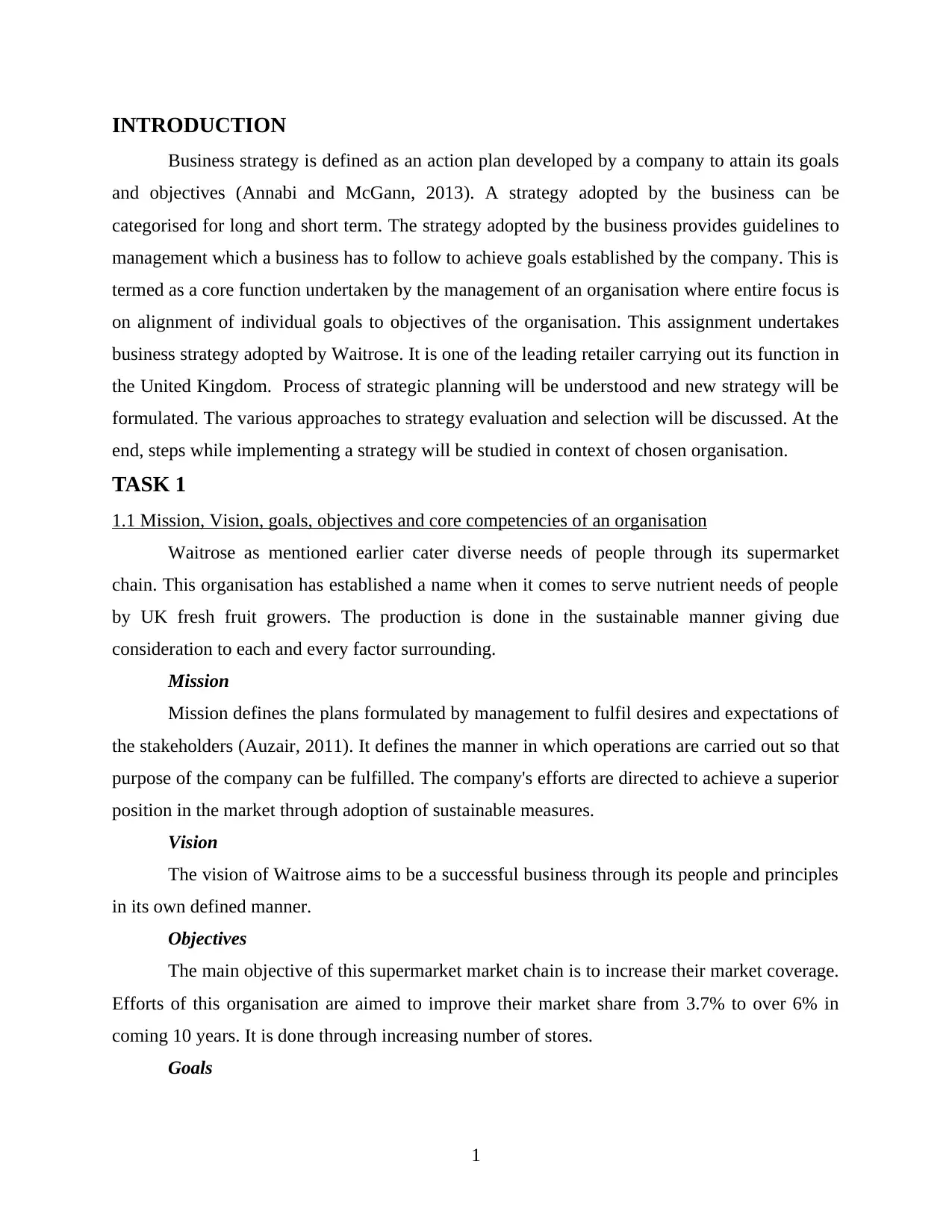
INTRODUCTION
Business strategy is defined as an action plan developed by a company to attain its goals
and objectives (Annabi and McGann, 2013). A strategy adopted by the business can be
categorised for long and short term. The strategy adopted by the business provides guidelines to
management which a business has to follow to achieve goals established by the company. This is
termed as a core function undertaken by the management of an organisation where entire focus is
on alignment of individual goals to objectives of the organisation. This assignment undertakes
business strategy adopted by Waitrose. It is one of the leading retailer carrying out its function in
the United Kingdom. Process of strategic planning will be understood and new strategy will be
formulated. The various approaches to strategy evaluation and selection will be discussed. At the
end, steps while implementing a strategy will be studied in context of chosen organisation.
TASK 1
1.1 Mission, Vision, goals, objectives and core competencies of an organisation
Waitrose as mentioned earlier cater diverse needs of people through its supermarket
chain. This organisation has established a name when it comes to serve nutrient needs of people
by UK fresh fruit growers. The production is done in the sustainable manner giving due
consideration to each and every factor surrounding.
Mission
Mission defines the plans formulated by management to fulfil desires and expectations of
the stakeholders (Auzair, 2011). It defines the manner in which operations are carried out so that
purpose of the company can be fulfilled. The company's efforts are directed to achieve a superior
position in the market through adoption of sustainable measures.
Vision
The vision of Waitrose aims to be a successful business through its people and principles
in its own defined manner.
Objectives
The main objective of this supermarket market chain is to increase their market coverage.
Efforts of this organisation are aimed to improve their market share from 3.7% to over 6% in
coming 10 years. It is done through increasing number of stores.
Goals
1
Business strategy is defined as an action plan developed by a company to attain its goals
and objectives (Annabi and McGann, 2013). A strategy adopted by the business can be
categorised for long and short term. The strategy adopted by the business provides guidelines to
management which a business has to follow to achieve goals established by the company. This is
termed as a core function undertaken by the management of an organisation where entire focus is
on alignment of individual goals to objectives of the organisation. This assignment undertakes
business strategy adopted by Waitrose. It is one of the leading retailer carrying out its function in
the United Kingdom. Process of strategic planning will be understood and new strategy will be
formulated. The various approaches to strategy evaluation and selection will be discussed. At the
end, steps while implementing a strategy will be studied in context of chosen organisation.
TASK 1
1.1 Mission, Vision, goals, objectives and core competencies of an organisation
Waitrose as mentioned earlier cater diverse needs of people through its supermarket
chain. This organisation has established a name when it comes to serve nutrient needs of people
by UK fresh fruit growers. The production is done in the sustainable manner giving due
consideration to each and every factor surrounding.
Mission
Mission defines the plans formulated by management to fulfil desires and expectations of
the stakeholders (Auzair, 2011). It defines the manner in which operations are carried out so that
purpose of the company can be fulfilled. The company's efforts are directed to achieve a superior
position in the market through adoption of sustainable measures.
Vision
The vision of Waitrose aims to be a successful business through its people and principles
in its own defined manner.
Objectives
The main objective of this supermarket market chain is to increase their market coverage.
Efforts of this organisation are aimed to improve their market share from 3.7% to over 6% in
coming 10 years. It is done through increasing number of stores.
Goals
1
⊘ This is a preview!⊘
Do you want full access?
Subscribe today to unlock all pages.

Trusted by 1+ million students worldwide

Goals are the objectives formulated by the company for a shorter duration of time. Goals
of Waitrose are to provide value services to customer and increasing digits of sales volume of the
company adopting a suitable promotional tool.
Core competencies
Core competencies are defined to be major strengths of the company achieved through
association of knowledge and technological capabilities of an organisation (Boies, Lvina and
Martens, 2011). This supermarket chain is known to possess a superior position in market
through its food retailing services. The company carry an expertise in food and drink sector and
emphasis on freshness quality and value.
1.2 Analysis of the factors that have to be considered while formulating strategic plan
There are variety of factors which are to be considered while formulating a strategic plan.
Management has to ensure that vision of the company is to be attained with the help of strategies
developed. The main factors which are to be undertaken while formulating a business plan are as
follows:
Engagement: Large number of organisation employ a formal strategy planning process to
make important decisions. Engagement ensures that employee's opinion and ideas are taken into
consideration before formulating a plan so that major problems and issues can manifest.
Communication: It is a trend that major strategies developed in an organisation does not
conform to organisational vision. It is necessary for a business to have up-down and bottom up
approach to make sure that employees are aware of decision being taken by the management
(Butler, 2012). It is necessary for a business to conduct surveys to involve inputs of employees in
decision making.
Innovation: This is another crucial aspect in an organisation. As the major initiatives or
decision made by the company are in the sector of product development and innovation. The
company should involve innovation to ensure a certain level of success through risk taking
initiatives.
Project management: It is very necessary for management to thoroughly understand the
strategy of the company. The reason for the same is that strategy defines projects which are to be
undertaken so that success can be attained. The two factors which are crucial in this domain are
employee involvement and commitment.
2
of Waitrose are to provide value services to customer and increasing digits of sales volume of the
company adopting a suitable promotional tool.
Core competencies
Core competencies are defined to be major strengths of the company achieved through
association of knowledge and technological capabilities of an organisation (Boies, Lvina and
Martens, 2011). This supermarket chain is known to possess a superior position in market
through its food retailing services. The company carry an expertise in food and drink sector and
emphasis on freshness quality and value.
1.2 Analysis of the factors that have to be considered while formulating strategic plan
There are variety of factors which are to be considered while formulating a strategic plan.
Management has to ensure that vision of the company is to be attained with the help of strategies
developed. The main factors which are to be undertaken while formulating a business plan are as
follows:
Engagement: Large number of organisation employ a formal strategy planning process to
make important decisions. Engagement ensures that employee's opinion and ideas are taken into
consideration before formulating a plan so that major problems and issues can manifest.
Communication: It is a trend that major strategies developed in an organisation does not
conform to organisational vision. It is necessary for a business to have up-down and bottom up
approach to make sure that employees are aware of decision being taken by the management
(Butler, 2012). It is necessary for a business to conduct surveys to involve inputs of employees in
decision making.
Innovation: This is another crucial aspect in an organisation. As the major initiatives or
decision made by the company are in the sector of product development and innovation. The
company should involve innovation to ensure a certain level of success through risk taking
initiatives.
Project management: It is very necessary for management to thoroughly understand the
strategy of the company. The reason for the same is that strategy defines projects which are to be
undertaken so that success can be attained. The two factors which are crucial in this domain are
employee involvement and commitment.
2
Paraphrase This Document
Need a fresh take? Get an instant paraphrase of this document with our AI Paraphraser
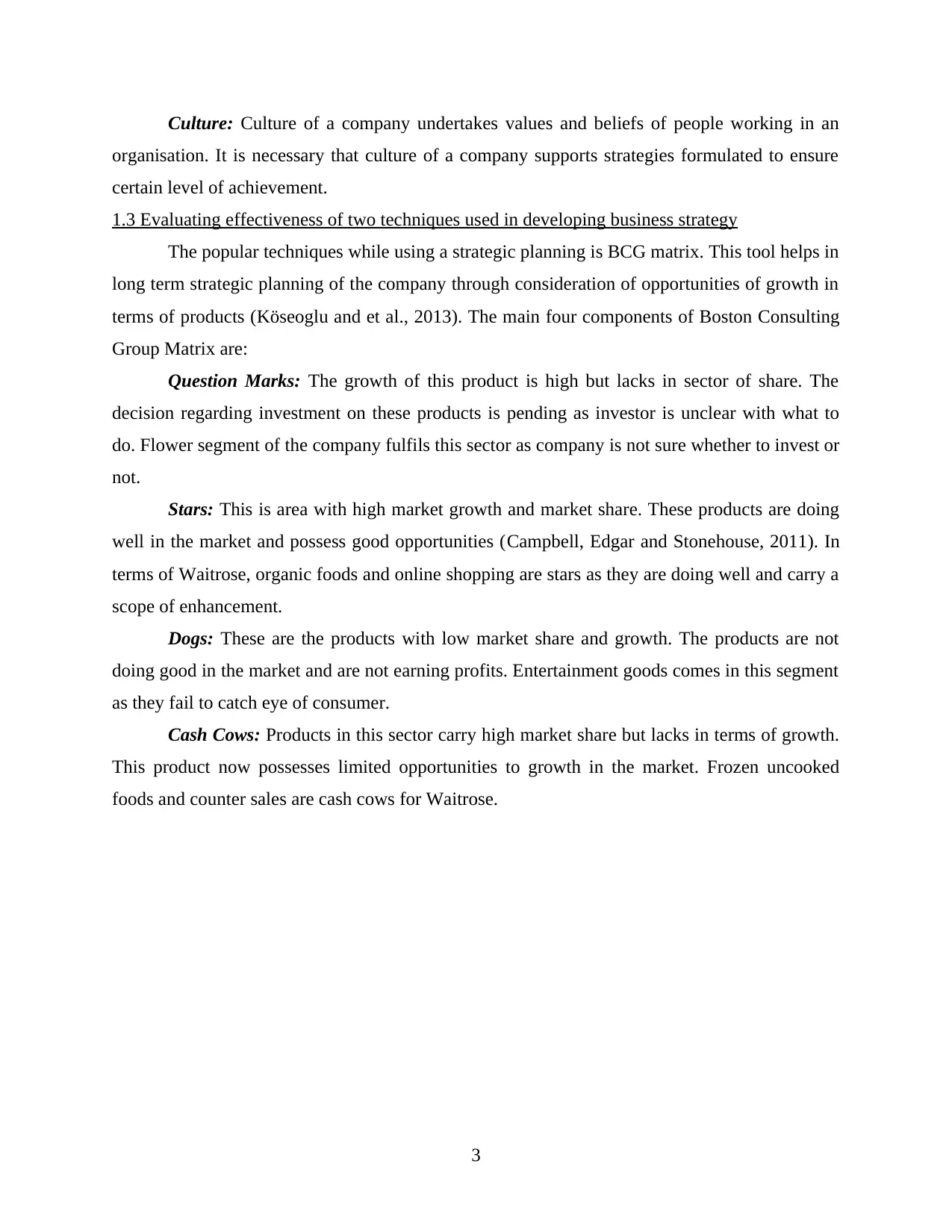
Culture: Culture of a company undertakes values and beliefs of people working in an
organisation. It is necessary that culture of a company supports strategies formulated to ensure
certain level of achievement.
1.3 Evaluating effectiveness of two techniques used in developing business strategy
The popular techniques while using a strategic planning is BCG matrix. This tool helps in
long term strategic planning of the company through consideration of opportunities of growth in
terms of products (Köseoglu and et al., 2013). The main four components of Boston Consulting
Group Matrix are:
Question Marks: The growth of this product is high but lacks in sector of share. The
decision regarding investment on these products is pending as investor is unclear with what to
do. Flower segment of the company fulfils this sector as company is not sure whether to invest or
not.
Stars: This is area with high market growth and market share. These products are doing
well in the market and possess good opportunities (Campbell, Edgar and Stonehouse, 2011). In
terms of Waitrose, organic foods and online shopping are stars as they are doing well and carry a
scope of enhancement.
Dogs: These are the products with low market share and growth. The products are not
doing good in the market and are not earning profits. Entertainment goods comes in this segment
as they fail to catch eye of consumer.
Cash Cows: Products in this sector carry high market share but lacks in terms of growth.
This product now possesses limited opportunities to growth in the market. Frozen uncooked
foods and counter sales are cash cows for Waitrose.
3
organisation. It is necessary that culture of a company supports strategies formulated to ensure
certain level of achievement.
1.3 Evaluating effectiveness of two techniques used in developing business strategy
The popular techniques while using a strategic planning is BCG matrix. This tool helps in
long term strategic planning of the company through consideration of opportunities of growth in
terms of products (Köseoglu and et al., 2013). The main four components of Boston Consulting
Group Matrix are:
Question Marks: The growth of this product is high but lacks in sector of share. The
decision regarding investment on these products is pending as investor is unclear with what to
do. Flower segment of the company fulfils this sector as company is not sure whether to invest or
not.
Stars: This is area with high market growth and market share. These products are doing
well in the market and possess good opportunities (Campbell, Edgar and Stonehouse, 2011). In
terms of Waitrose, organic foods and online shopping are stars as they are doing well and carry a
scope of enhancement.
Dogs: These are the products with low market share and growth. The products are not
doing good in the market and are not earning profits. Entertainment goods comes in this segment
as they fail to catch eye of consumer.
Cash Cows: Products in this sector carry high market share but lacks in terms of growth.
This product now possesses limited opportunities to growth in the market. Frozen uncooked
foods and counter sales are cash cows for Waitrose.
3
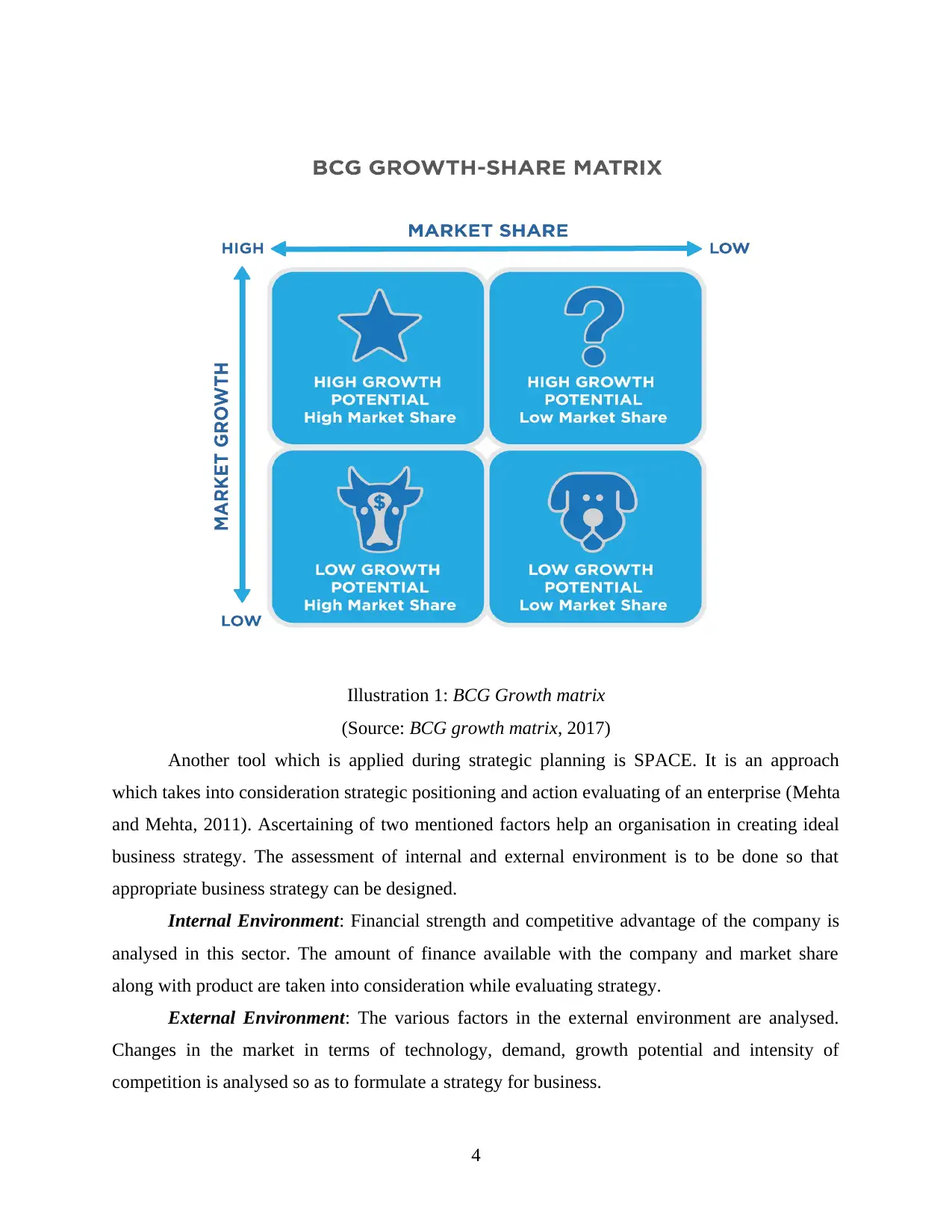
(Source: BCG growth matrix, 2017)
Another tool which is applied during strategic planning is SPACE. It is an approach
which takes into consideration strategic positioning and action evaluating of an enterprise (Mehta
and Mehta, 2011). Ascertaining of two mentioned factors help an organisation in creating ideal
business strategy. The assessment of internal and external environment is to be done so that
appropriate business strategy can be designed.
Internal Environment: Financial strength and competitive advantage of the company is
analysed in this sector. The amount of finance available with the company and market share
along with product are taken into consideration while evaluating strategy.
External Environment: The various factors in the external environment are analysed.
Changes in the market in terms of technology, demand, growth potential and intensity of
competition is analysed so as to formulate a strategy for business.
4
Illustration 1: BCG Growth matrix
Another tool which is applied during strategic planning is SPACE. It is an approach
which takes into consideration strategic positioning and action evaluating of an enterprise (Mehta
and Mehta, 2011). Ascertaining of two mentioned factors help an organisation in creating ideal
business strategy. The assessment of internal and external environment is to be done so that
appropriate business strategy can be designed.
Internal Environment: Financial strength and competitive advantage of the company is
analysed in this sector. The amount of finance available with the company and market share
along with product are taken into consideration while evaluating strategy.
External Environment: The various factors in the external environment are analysed.
Changes in the market in terms of technology, demand, growth potential and intensity of
competition is analysed so as to formulate a strategy for business.
4
Illustration 1: BCG Growth matrix
⊘ This is a preview!⊘
Do you want full access?
Subscribe today to unlock all pages.

Trusted by 1+ million students worldwide
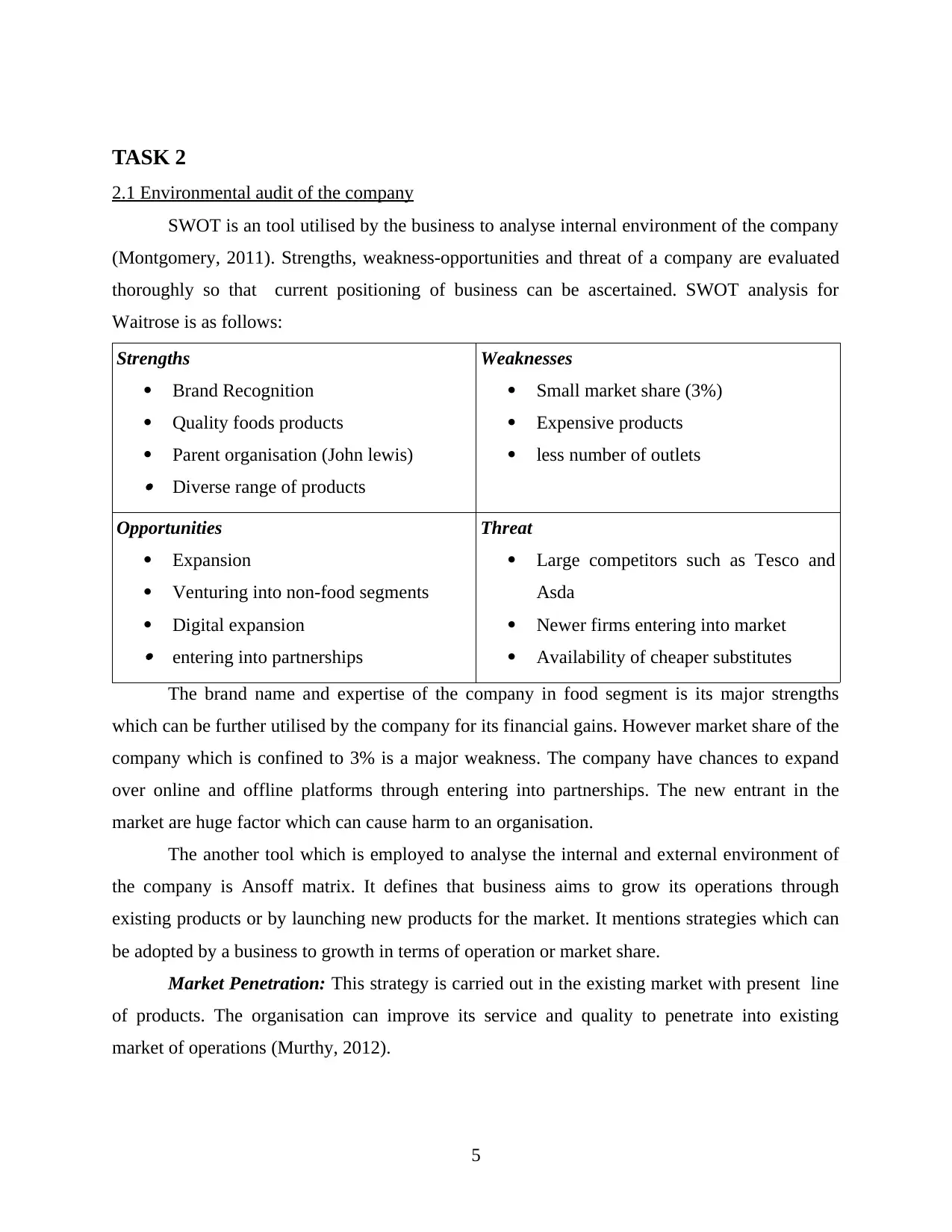
TASK 2
2.1 Environmental audit of the company
SWOT is an tool utilised by the business to analyse internal environment of the company
(Montgomery, 2011). Strengths, weakness-opportunities and threat of a company are evaluated
thoroughly so that current positioning of business can be ascertained. SWOT analysis for
Waitrose is as follows:
Strengths
Brand Recognition
Quality foods products
Parent organisation (John lewis) Diverse range of products
Weaknesses
Small market share (3%)
Expensive products
less number of outlets
Opportunities
Expansion
Venturing into non-food segments
Digital expansion entering into partnerships
Threat
Large competitors such as Tesco and
Asda
Newer firms entering into market
Availability of cheaper substitutes
The brand name and expertise of the company in food segment is its major strengths
which can be further utilised by the company for its financial gains. However market share of the
company which is confined to 3% is a major weakness. The company have chances to expand
over online and offline platforms through entering into partnerships. The new entrant in the
market are huge factor which can cause harm to an organisation.
The another tool which is employed to analyse the internal and external environment of
the company is Ansoff matrix. It defines that business aims to grow its operations through
existing products or by launching new products for the market. It mentions strategies which can
be adopted by a business to growth in terms of operation or market share.
Market Penetration: This strategy is carried out in the existing market with present line
of products. The organisation can improve its service and quality to penetrate into existing
market of operations (Murthy, 2012).
5
2.1 Environmental audit of the company
SWOT is an tool utilised by the business to analyse internal environment of the company
(Montgomery, 2011). Strengths, weakness-opportunities and threat of a company are evaluated
thoroughly so that current positioning of business can be ascertained. SWOT analysis for
Waitrose is as follows:
Strengths
Brand Recognition
Quality foods products
Parent organisation (John lewis) Diverse range of products
Weaknesses
Small market share (3%)
Expensive products
less number of outlets
Opportunities
Expansion
Venturing into non-food segments
Digital expansion entering into partnerships
Threat
Large competitors such as Tesco and
Asda
Newer firms entering into market
Availability of cheaper substitutes
The brand name and expertise of the company in food segment is its major strengths
which can be further utilised by the company for its financial gains. However market share of the
company which is confined to 3% is a major weakness. The company have chances to expand
over online and offline platforms through entering into partnerships. The new entrant in the
market are huge factor which can cause harm to an organisation.
The another tool which is employed to analyse the internal and external environment of
the company is Ansoff matrix. It defines that business aims to grow its operations through
existing products or by launching new products for the market. It mentions strategies which can
be adopted by a business to growth in terms of operation or market share.
Market Penetration: This strategy is carried out in the existing market with present line
of products. The organisation can improve its service and quality to penetrate into existing
market of operations (Murthy, 2012).
5
Paraphrase This Document
Need a fresh take? Get an instant paraphrase of this document with our AI Paraphraser
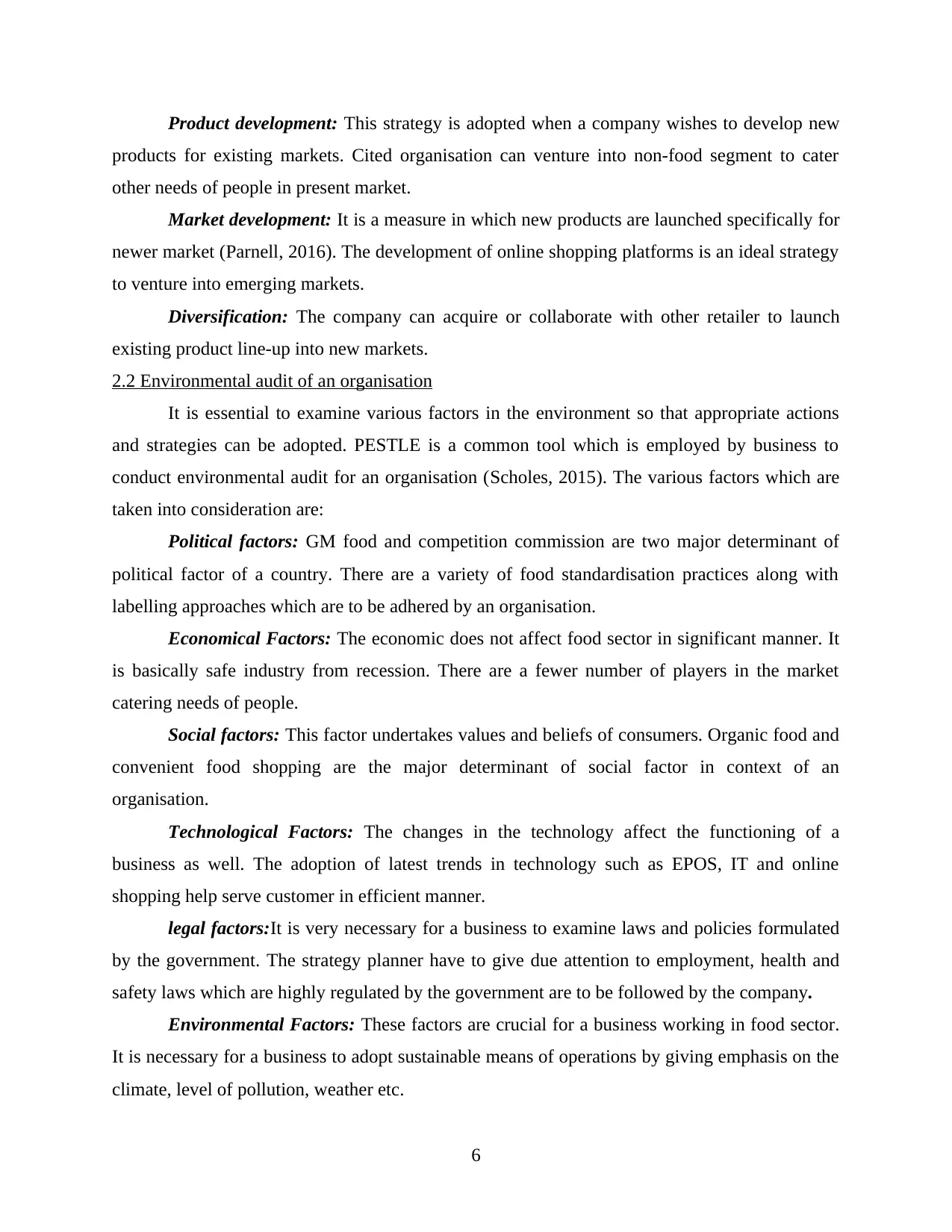
Product development: This strategy is adopted when a company wishes to develop new
products for existing markets. Cited organisation can venture into non-food segment to cater
other needs of people in present market.
Market development: It is a measure in which new products are launched specifically for
newer market (Parnell, 2016). The development of online shopping platforms is an ideal strategy
to venture into emerging markets.
Diversification: The company can acquire or collaborate with other retailer to launch
existing product line-up into new markets.
2.2 Environmental audit of an organisation
It is essential to examine various factors in the environment so that appropriate actions
and strategies can be adopted. PESTLE is a common tool which is employed by business to
conduct environmental audit for an organisation (Scholes, 2015). The various factors which are
taken into consideration are:
Political factors: GM food and competition commission are two major determinant of
political factor of a country. There are a variety of food standardisation practices along with
labelling approaches which are to be adhered by an organisation.
Economical Factors: The economic does not affect food sector in significant manner. It
is basically safe industry from recession. There are a fewer number of players in the market
catering needs of people.
Social factors: This factor undertakes values and beliefs of consumers. Organic food and
convenient food shopping are the major determinant of social factor in context of an
organisation.
Technological Factors: The changes in the technology affect the functioning of a
business as well. The adoption of latest trends in technology such as EPOS, IT and online
shopping help serve customer in efficient manner.
legal factors:It is very necessary for a business to examine laws and policies formulated
by the government. The strategy planner have to give due attention to employment, health and
safety laws which are highly regulated by the government are to be followed by the company.
Environmental Factors: These factors are crucial for a business working in food sector.
It is necessary for a business to adopt sustainable means of operations by giving emphasis on the
climate, level of pollution, weather etc.
6
products for existing markets. Cited organisation can venture into non-food segment to cater
other needs of people in present market.
Market development: It is a measure in which new products are launched specifically for
newer market (Parnell, 2016). The development of online shopping platforms is an ideal strategy
to venture into emerging markets.
Diversification: The company can acquire or collaborate with other retailer to launch
existing product line-up into new markets.
2.2 Environmental audit of an organisation
It is essential to examine various factors in the environment so that appropriate actions
and strategies can be adopted. PESTLE is a common tool which is employed by business to
conduct environmental audit for an organisation (Scholes, 2015). The various factors which are
taken into consideration are:
Political factors: GM food and competition commission are two major determinant of
political factor of a country. There are a variety of food standardisation practices along with
labelling approaches which are to be adhered by an organisation.
Economical Factors: The economic does not affect food sector in significant manner. It
is basically safe industry from recession. There are a fewer number of players in the market
catering needs of people.
Social factors: This factor undertakes values and beliefs of consumers. Organic food and
convenient food shopping are the major determinant of social factor in context of an
organisation.
Technological Factors: The changes in the technology affect the functioning of a
business as well. The adoption of latest trends in technology such as EPOS, IT and online
shopping help serve customer in efficient manner.
legal factors:It is very necessary for a business to examine laws and policies formulated
by the government. The strategy planner have to give due attention to employment, health and
safety laws which are highly regulated by the government are to be followed by the company.
Environmental Factors: These factors are crucial for a business working in food sector.
It is necessary for a business to adopt sustainable means of operations by giving emphasis on the
climate, level of pollution, weather etc.
6
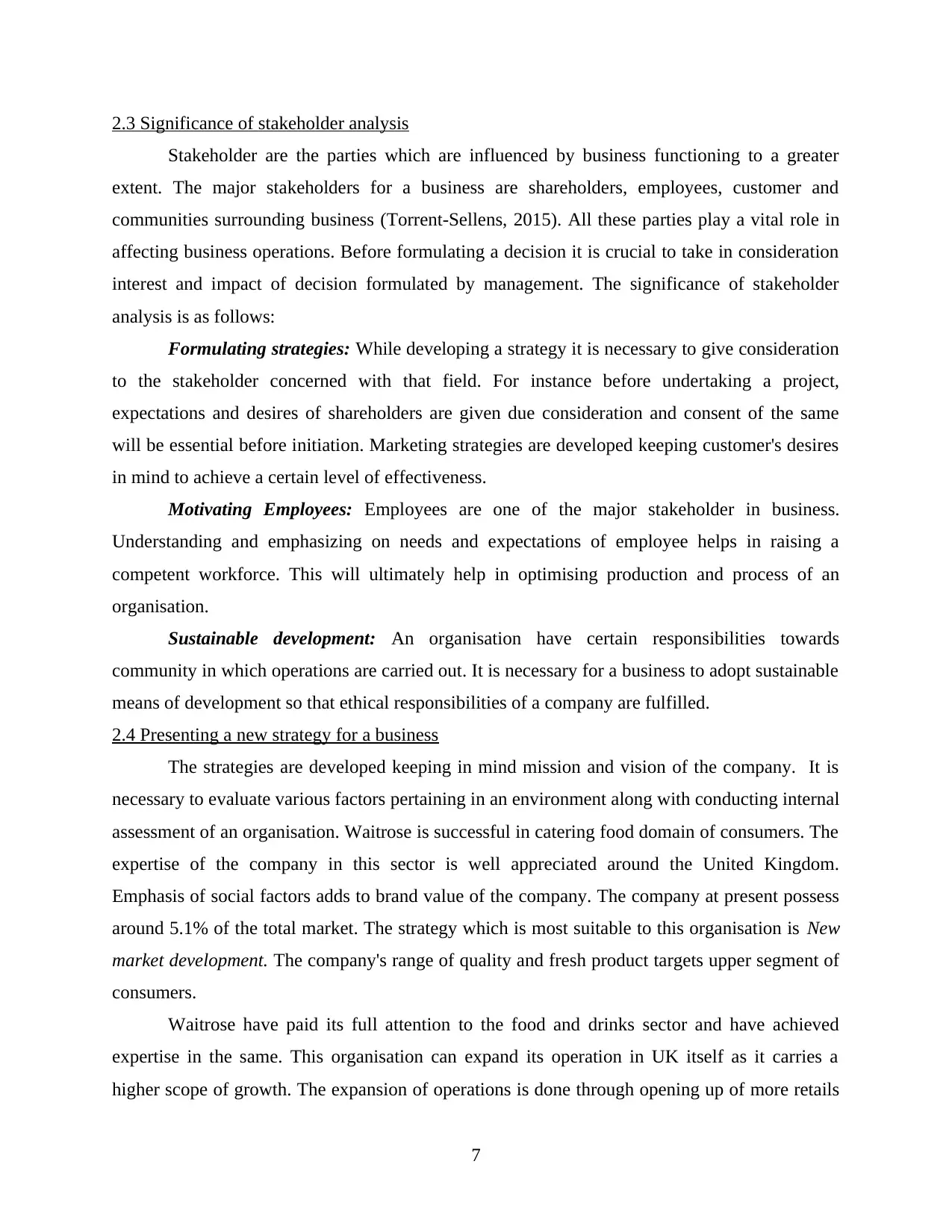
2.3 Significance of stakeholder analysis
Stakeholder are the parties which are influenced by business functioning to a greater
extent. The major stakeholders for a business are shareholders, employees, customer and
communities surrounding business (Torrent-Sellens, 2015). All these parties play a vital role in
affecting business operations. Before formulating a decision it is crucial to take in consideration
interest and impact of decision formulated by management. The significance of stakeholder
analysis is as follows:
Formulating strategies: While developing a strategy it is necessary to give consideration
to the stakeholder concerned with that field. For instance before undertaking a project,
expectations and desires of shareholders are given due consideration and consent of the same
will be essential before initiation. Marketing strategies are developed keeping customer's desires
in mind to achieve a certain level of effectiveness.
Motivating Employees: Employees are one of the major stakeholder in business.
Understanding and emphasizing on needs and expectations of employee helps in raising a
competent workforce. This will ultimately help in optimising production and process of an
organisation.
Sustainable development: An organisation have certain responsibilities towards
community in which operations are carried out. It is necessary for a business to adopt sustainable
means of development so that ethical responsibilities of a company are fulfilled.
2.4 Presenting a new strategy for a business
The strategies are developed keeping in mind mission and vision of the company. It is
necessary to evaluate various factors pertaining in an environment along with conducting internal
assessment of an organisation. Waitrose is successful in catering food domain of consumers. The
expertise of the company in this sector is well appreciated around the United Kingdom.
Emphasis of social factors adds to brand value of the company. The company at present possess
around 5.1% of the total market. The strategy which is most suitable to this organisation is New
market development. The company's range of quality and fresh product targets upper segment of
consumers.
Waitrose have paid its full attention to the food and drinks sector and have achieved
expertise in the same. This organisation can expand its operation in UK itself as it carries a
higher scope of growth. The expansion of operations is done through opening up of more retails
7
Stakeholder are the parties which are influenced by business functioning to a greater
extent. The major stakeholders for a business are shareholders, employees, customer and
communities surrounding business (Torrent-Sellens, 2015). All these parties play a vital role in
affecting business operations. Before formulating a decision it is crucial to take in consideration
interest and impact of decision formulated by management. The significance of stakeholder
analysis is as follows:
Formulating strategies: While developing a strategy it is necessary to give consideration
to the stakeholder concerned with that field. For instance before undertaking a project,
expectations and desires of shareholders are given due consideration and consent of the same
will be essential before initiation. Marketing strategies are developed keeping customer's desires
in mind to achieve a certain level of effectiveness.
Motivating Employees: Employees are one of the major stakeholder in business.
Understanding and emphasizing on needs and expectations of employee helps in raising a
competent workforce. This will ultimately help in optimising production and process of an
organisation.
Sustainable development: An organisation have certain responsibilities towards
community in which operations are carried out. It is necessary for a business to adopt sustainable
means of development so that ethical responsibilities of a company are fulfilled.
2.4 Presenting a new strategy for a business
The strategies are developed keeping in mind mission and vision of the company. It is
necessary to evaluate various factors pertaining in an environment along with conducting internal
assessment of an organisation. Waitrose is successful in catering food domain of consumers. The
expertise of the company in this sector is well appreciated around the United Kingdom.
Emphasis of social factors adds to brand value of the company. The company at present possess
around 5.1% of the total market. The strategy which is most suitable to this organisation is New
market development. The company's range of quality and fresh product targets upper segment of
consumers.
Waitrose have paid its full attention to the food and drinks sector and have achieved
expertise in the same. This organisation can expand its operation in UK itself as it carries a
higher scope of growth. The expansion of operations is done through opening up of more retails
7
⊘ This is a preview!⊘
Do you want full access?
Subscribe today to unlock all pages.

Trusted by 1+ million students worldwide
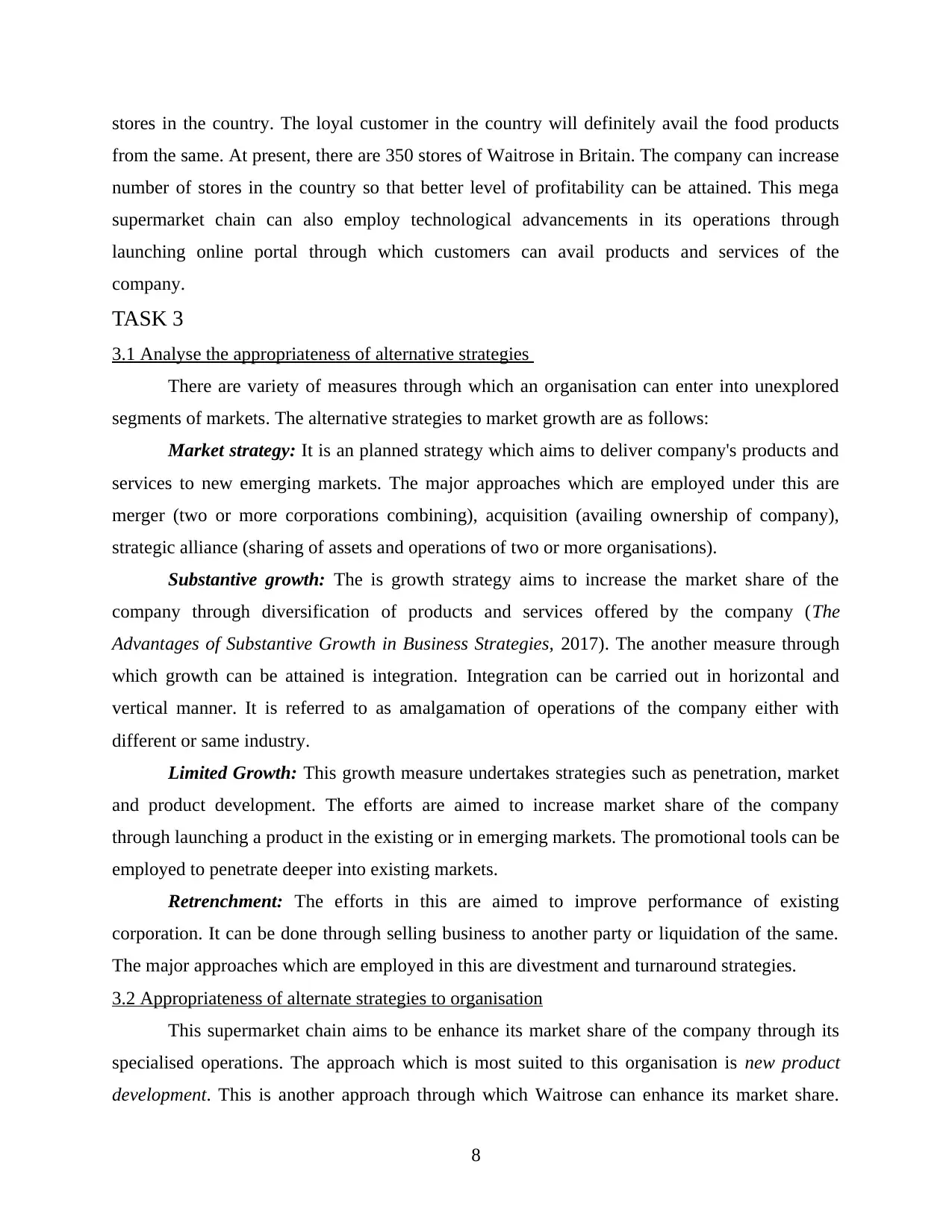
stores in the country. The loyal customer in the country will definitely avail the food products
from the same. At present, there are 350 stores of Waitrose in Britain. The company can increase
number of stores in the country so that better level of profitability can be attained. This mega
supermarket chain can also employ technological advancements in its operations through
launching online portal through which customers can avail products and services of the
company.
TASK 3
3.1 Analyse the appropriateness of alternative strategies
There are variety of measures through which an organisation can enter into unexplored
segments of markets. The alternative strategies to market growth are as follows:
Market strategy: It is an planned strategy which aims to deliver company's products and
services to new emerging markets. The major approaches which are employed under this are
merger (two or more corporations combining), acquisition (availing ownership of company),
strategic alliance (sharing of assets and operations of two or more organisations).
Substantive growth: The is growth strategy aims to increase the market share of the
company through diversification of products and services offered by the company (The
Advantages of Substantive Growth in Business Strategies, 2017). The another measure through
which growth can be attained is integration. Integration can be carried out in horizontal and
vertical manner. It is referred to as amalgamation of operations of the company either with
different or same industry.
Limited Growth: This growth measure undertakes strategies such as penetration, market
and product development. The efforts are aimed to increase market share of the company
through launching a product in the existing or in emerging markets. The promotional tools can be
employed to penetrate deeper into existing markets.
Retrenchment: The efforts in this are aimed to improve performance of existing
corporation. It can be done through selling business to another party or liquidation of the same.
The major approaches which are employed in this are divestment and turnaround strategies.
3.2 Appropriateness of alternate strategies to organisation
This supermarket chain aims to be enhance its market share of the company through its
specialised operations. The approach which is most suited to this organisation is new product
development. This is another approach through which Waitrose can enhance its market share.
8
from the same. At present, there are 350 stores of Waitrose in Britain. The company can increase
number of stores in the country so that better level of profitability can be attained. This mega
supermarket chain can also employ technological advancements in its operations through
launching online portal through which customers can avail products and services of the
company.
TASK 3
3.1 Analyse the appropriateness of alternative strategies
There are variety of measures through which an organisation can enter into unexplored
segments of markets. The alternative strategies to market growth are as follows:
Market strategy: It is an planned strategy which aims to deliver company's products and
services to new emerging markets. The major approaches which are employed under this are
merger (two or more corporations combining), acquisition (availing ownership of company),
strategic alliance (sharing of assets and operations of two or more organisations).
Substantive growth: The is growth strategy aims to increase the market share of the
company through diversification of products and services offered by the company (The
Advantages of Substantive Growth in Business Strategies, 2017). The another measure through
which growth can be attained is integration. Integration can be carried out in horizontal and
vertical manner. It is referred to as amalgamation of operations of the company either with
different or same industry.
Limited Growth: This growth measure undertakes strategies such as penetration, market
and product development. The efforts are aimed to increase market share of the company
through launching a product in the existing or in emerging markets. The promotional tools can be
employed to penetrate deeper into existing markets.
Retrenchment: The efforts in this are aimed to improve performance of existing
corporation. It can be done through selling business to another party or liquidation of the same.
The major approaches which are employed in this are divestment and turnaround strategies.
3.2 Appropriateness of alternate strategies to organisation
This supermarket chain aims to be enhance its market share of the company through its
specialised operations. The approach which is most suited to this organisation is new product
development. This is another approach through which Waitrose can enhance its market share.
8
Paraphrase This Document
Need a fresh take? Get an instant paraphrase of this document with our AI Paraphraser
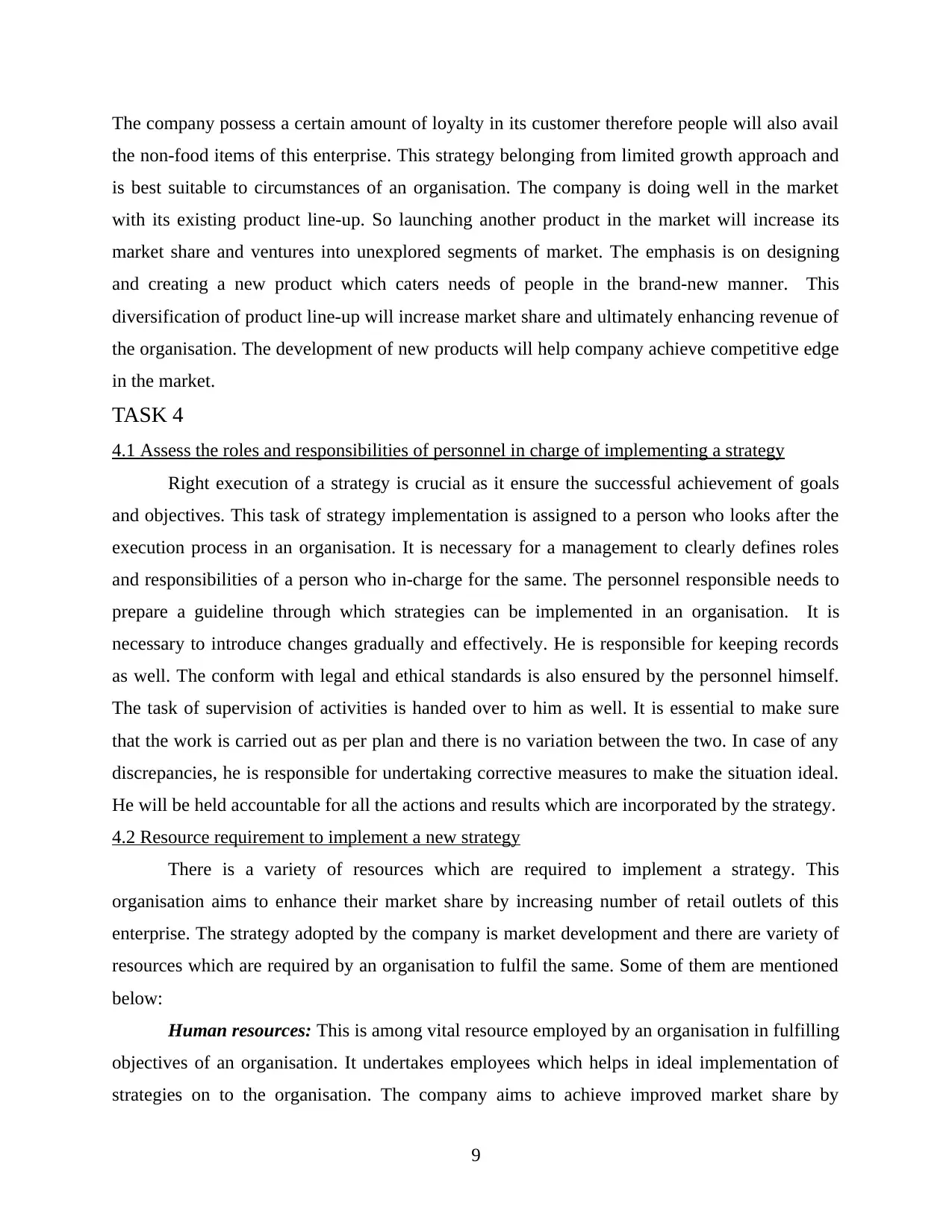
The company possess a certain amount of loyalty in its customer therefore people will also avail
the non-food items of this enterprise. This strategy belonging from limited growth approach and
is best suitable to circumstances of an organisation. The company is doing well in the market
with its existing product line-up. So launching another product in the market will increase its
market share and ventures into unexplored segments of market. The emphasis is on designing
and creating a new product which caters needs of people in the brand-new manner. This
diversification of product line-up will increase market share and ultimately enhancing revenue of
the organisation. The development of new products will help company achieve competitive edge
in the market.
TASK 4
4.1 Assess the roles and responsibilities of personnel in charge of implementing a strategy
Right execution of a strategy is crucial as it ensure the successful achievement of goals
and objectives. This task of strategy implementation is assigned to a person who looks after the
execution process in an organisation. It is necessary for a management to clearly defines roles
and responsibilities of a person who in-charge for the same. The personnel responsible needs to
prepare a guideline through which strategies can be implemented in an organisation. It is
necessary to introduce changes gradually and effectively. He is responsible for keeping records
as well. The conform with legal and ethical standards is also ensured by the personnel himself.
The task of supervision of activities is handed over to him as well. It is essential to make sure
that the work is carried out as per plan and there is no variation between the two. In case of any
discrepancies, he is responsible for undertaking corrective measures to make the situation ideal.
He will be held accountable for all the actions and results which are incorporated by the strategy.
4.2 Resource requirement to implement a new strategy
There is a variety of resources which are required to implement a strategy. This
organisation aims to enhance their market share by increasing number of retail outlets of this
enterprise. The strategy adopted by the company is market development and there are variety of
resources which are required by an organisation to fulfil the same. Some of them are mentioned
below:
Human resources: This is among vital resource employed by an organisation in fulfilling
objectives of an organisation. It undertakes employees which helps in ideal implementation of
strategies on to the organisation. The company aims to achieve improved market share by
9
the non-food items of this enterprise. This strategy belonging from limited growth approach and
is best suitable to circumstances of an organisation. The company is doing well in the market
with its existing product line-up. So launching another product in the market will increase its
market share and ventures into unexplored segments of market. The emphasis is on designing
and creating a new product which caters needs of people in the brand-new manner. This
diversification of product line-up will increase market share and ultimately enhancing revenue of
the organisation. The development of new products will help company achieve competitive edge
in the market.
TASK 4
4.1 Assess the roles and responsibilities of personnel in charge of implementing a strategy
Right execution of a strategy is crucial as it ensure the successful achievement of goals
and objectives. This task of strategy implementation is assigned to a person who looks after the
execution process in an organisation. It is necessary for a management to clearly defines roles
and responsibilities of a person who in-charge for the same. The personnel responsible needs to
prepare a guideline through which strategies can be implemented in an organisation. It is
necessary to introduce changes gradually and effectively. He is responsible for keeping records
as well. The conform with legal and ethical standards is also ensured by the personnel himself.
The task of supervision of activities is handed over to him as well. It is essential to make sure
that the work is carried out as per plan and there is no variation between the two. In case of any
discrepancies, he is responsible for undertaking corrective measures to make the situation ideal.
He will be held accountable for all the actions and results which are incorporated by the strategy.
4.2 Resource requirement to implement a new strategy
There is a variety of resources which are required to implement a strategy. This
organisation aims to enhance their market share by increasing number of retail outlets of this
enterprise. The strategy adopted by the company is market development and there are variety of
resources which are required by an organisation to fulfil the same. Some of them are mentioned
below:
Human resources: This is among vital resource employed by an organisation in fulfilling
objectives of an organisation. It undertakes employees which helps in ideal implementation of
strategies on to the organisation. The company aims to achieve improved market share by
9
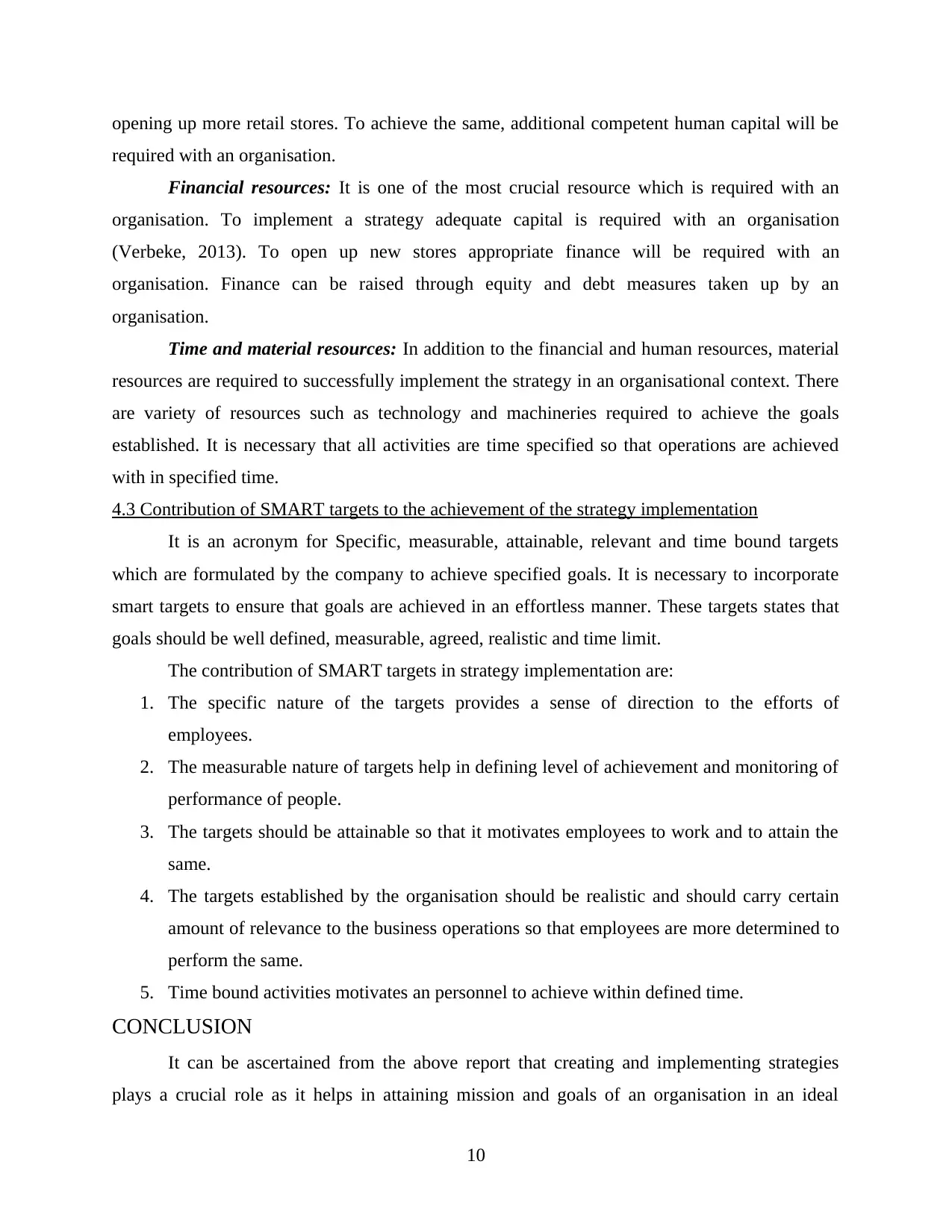
opening up more retail stores. To achieve the same, additional competent human capital will be
required with an organisation.
Financial resources: It is one of the most crucial resource which is required with an
organisation. To implement a strategy adequate capital is required with an organisation
(Verbeke, 2013). To open up new stores appropriate finance will be required with an
organisation. Finance can be raised through equity and debt measures taken up by an
organisation.
Time and material resources: In addition to the financial and human resources, material
resources are required to successfully implement the strategy in an organisational context. There
are variety of resources such as technology and machineries required to achieve the goals
established. It is necessary that all activities are time specified so that operations are achieved
with in specified time.
4.3 Contribution of SMART targets to the achievement of the strategy implementation
It is an acronym for Specific, measurable, attainable, relevant and time bound targets
which are formulated by the company to achieve specified goals. It is necessary to incorporate
smart targets to ensure that goals are achieved in an effortless manner. These targets states that
goals should be well defined, measurable, agreed, realistic and time limit.
The contribution of SMART targets in strategy implementation are:
1. The specific nature of the targets provides a sense of direction to the efforts of
employees.
2. The measurable nature of targets help in defining level of achievement and monitoring of
performance of people.
3. The targets should be attainable so that it motivates employees to work and to attain the
same.
4. The targets established by the organisation should be realistic and should carry certain
amount of relevance to the business operations so that employees are more determined to
perform the same.
5. Time bound activities motivates an personnel to achieve within defined time.
CONCLUSION
It can be ascertained from the above report that creating and implementing strategies
plays a crucial role as it helps in attaining mission and goals of an organisation in an ideal
10
required with an organisation.
Financial resources: It is one of the most crucial resource which is required with an
organisation. To implement a strategy adequate capital is required with an organisation
(Verbeke, 2013). To open up new stores appropriate finance will be required with an
organisation. Finance can be raised through equity and debt measures taken up by an
organisation.
Time and material resources: In addition to the financial and human resources, material
resources are required to successfully implement the strategy in an organisational context. There
are variety of resources such as technology and machineries required to achieve the goals
established. It is necessary that all activities are time specified so that operations are achieved
with in specified time.
4.3 Contribution of SMART targets to the achievement of the strategy implementation
It is an acronym for Specific, measurable, attainable, relevant and time bound targets
which are formulated by the company to achieve specified goals. It is necessary to incorporate
smart targets to ensure that goals are achieved in an effortless manner. These targets states that
goals should be well defined, measurable, agreed, realistic and time limit.
The contribution of SMART targets in strategy implementation are:
1. The specific nature of the targets provides a sense of direction to the efforts of
employees.
2. The measurable nature of targets help in defining level of achievement and monitoring of
performance of people.
3. The targets should be attainable so that it motivates employees to work and to attain the
same.
4. The targets established by the organisation should be realistic and should carry certain
amount of relevance to the business operations so that employees are more determined to
perform the same.
5. Time bound activities motivates an personnel to achieve within defined time.
CONCLUSION
It can be ascertained from the above report that creating and implementing strategies
plays a crucial role as it helps in attaining mission and goals of an organisation in an ideal
10
⊘ This is a preview!⊘
Do you want full access?
Subscribe today to unlock all pages.

Trusted by 1+ million students worldwide
1 out of 14
Related Documents
Your All-in-One AI-Powered Toolkit for Academic Success.
+13062052269
info@desklib.com
Available 24*7 on WhatsApp / Email
![[object Object]](/_next/static/media/star-bottom.7253800d.svg)
Unlock your academic potential
Copyright © 2020–2025 A2Z Services. All Rights Reserved. Developed and managed by ZUCOL.





